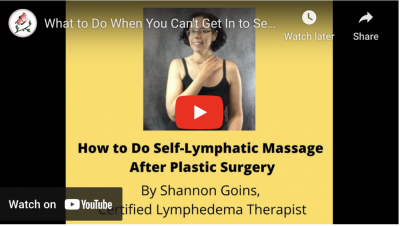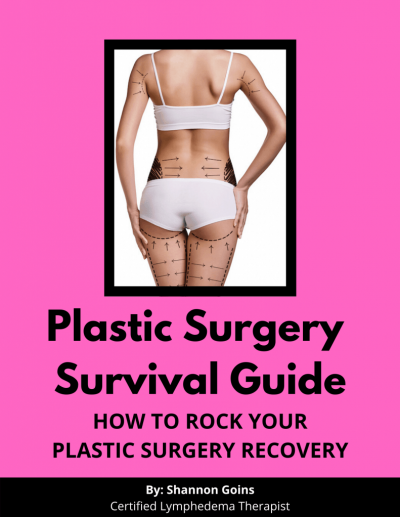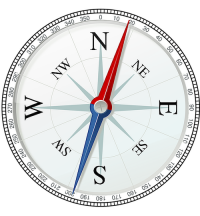What to Do When You Can’t Get a Lymphatic Massage After Plastic Surgery:
Instructions for Self-Lymphatic Massage

Sometimes we can’t get a
lymphatic massage
after plastic surgery…
and that can be stressful.
Here’s how to do basic
self lymphatic massage in the meantime.
While getting lymphatic massage from a qualified therapist after your procedure is the best plan
(and highly-recommended for the best and fastest results),
it isn’t always possible.)
(While this info is specifically prepared for people who have had plastic surgery, it applies to swelling from all surgeries, and covers some of the basics for people doing self-MLD for lymphedema management.)
If you can’t get in to see a lymphatic massage therapist
after your plastic surgery,
don’t be scared.
You are going to be ok.
There are things you can do for yourself to help you heal better and faster.
Sure, you are going to heal more slowly than without a professional therapist working on you,
and you might get a few lumps,
but those can be fixed.
Take a deep breath, and read on.
This video explains and gives brief demonstrations of the principles of lymphatic massage. The same information is covered in text format below.
I encourage you to both watch the video and read the text below because there is additional information in the text that isn’t in the video that is helpful and aids in understanding.
Additionally in the text below there is information not covered in the video on facelift protocols and compression recommendations.
**Please note that the information provided on this page is not intended to be a fully exhaustive guide for lymphatic massage, nor should you rely solely on this for your recovery. (Although it is fine to do this in addition to regular lymphatic massage by a licensed professional therapist.)
It is intended to cover the very basic steps of lymphatic massage in a lay-person fashion so that people who are unable to get lymphatic massage from a qualified professional can help themselves in their recovery.**
If you are having a hard time locating a therapist,
here is how to find a good post op massage therapist.
Here are super important things to watch out for when choosing a lymphatic massage therapist post op.
If you have recently had surgery, right now you are probably very swollen and sore. It is normal to have a pretty good amount of swelling and discomfort after surgery.
Of course, always contact your plastic surgeon if you have concerns and think something is wrong. They can advise you best.
That being said, there are LOTS of things the plastic surgeon didn’t tell you about regarding the day-to-day recovery. I wrote a blog post about that here on What is Normal After Plastic Surgery (And What Isn’t).
Why You Get Swelling
Any time the body has a trauma – like a sprained ankle or hand that gets slammed in a car door – or surgery, it sends fluid to splint the area to prevent further injury. Swelling also is like “Door Dash” for the cells and brings with it lots of nutrients and repair molecules. Having fluid there short-term will not hurt you. Leaving it for a long time can have unwanted consequences.
What Happens If You Don’t Get Lymphatic Massage After Plastic Surgery?
Having fluid there a little longer after surgery is usually only a minor problem as it can cause lumps and bumps (which no one wants) and you will heal a bit more slowly, but it is no cause for panic. They can be fixed. So long as you get to them in the near future, it’s not that big of a deal.
When I say it’s not a huge deal if you have some extra swelling for a few weeks, don’t wait a year or two – or 3 months for that matter. You do need to address the swelling, but a few weeks isn’t a big deal. If you don’t get lymphatic massage at all after plastic surgery you can develop lumps and bumps that can be extremely difficult to get rid of long term. It isn’t guaranteed that they can be totally resolved if you wait months before getting your first lymphatic massage, and it will cost you much more time and money on the back end.
It is better if you can avoid them forming altogether, which is why I am putting this info out there for you guys so you can do some work at home until you can get in to see a qualified therapist.
Why I Have Made This Page and Video
As a Certified Lymphedema Therapist I see a lot of incorrect information
out on the Internet about Self Lymphatic Massage.
I’m writing this as a fully qualified practitioner who specializes in plastic surgery recovery to help make sure that there is good and accurate information available to people who are unable to get to a therapist for lymphatic massage.
One example of this inaccurate information is that fluid must be pushed out of open incisions. (Read more here about the Dirty Little Secrets About the Plastic Surgery Recovery Industry.)
True *lymphatic* drainage uses the body’s lymphatic system (a complex network of special vessels like veins) to pull the fluid away from the tissues and return it to the bloodstream. This is how the body deals with swelling naturally and true lymphatic therapists make this happen faster and better.
Therapists who open incisions or who try to force fluid out of them are *not* doing lymphatic work at all. They are doing “incisional drainage.” This is against state laws for a massage therapist to do this (although many do in places like Miami). It also leaves their clients more prone to infection.
Just a reminder to make sure that you have a qualified therapist who has at a bare minimum Manual Lymphatic Drainage (MLD) certification, or even better is a Certified Lymphedema Therapist (CLT).
If you know someone who could use this information,
please pass it along!
IMPORTANT! Even if you are recovering from surgery and are swollen,
DO NOT perform this procedure
if you think you may be sick or have an infection!
Read Step 2 – clearing the lymph nodes for more info.
Where the Fluid Goes
Before we talk about how to do lymphatic massage after plastic surgery, it’s important to understand some basics of what we are trying to accomplish when we work on ourselves. This helps ensure that we do it correctly.
The most pressing idea to understand is
where the fluid is being moved to in the body.
The fluid originally comes out of our bloodstream and it is returned to the bloodstream via the “highways” of the lymphatic system. These highways are called lymphatic vessels.
The end-point (or terminus) of the lymphatic system is right under our collar bones.
(If you would like to watch a video of
how the lymphatic system works, click here.)

Lymphatic Terminals - Where the Lymph (fluid) Drains to in the Body
Before you start there are a few important things to know:
- Be sure to wash your hands (with soap). If you have just had surgery, you have open wounds that are prone to infection. Even if they are covered in tape or bandages, you still need clean hands before you touch your body.
- While performing these techniques, DO NOT TOUCH OPEN WOUNDS. Open wounds are surgical incisions that have not completely healed. Completely healed means that the scabs have come off of the incisions naturally and that everything is closed.
- When tugging on the skin in Step 3, keep in mind that you have open wounds that often have stitches holding things together. Don’t tug so tight that you are pulling tight on your scar area.
CAUTION!
A Note About BBL’s and Fat Transfers to the Breast or Face
If you have recently had a BBL (Brazilian Butt Lift) or Fat Transfer to the Breast it is important that you keep in mind that many doctors don’t want you to touch the area of injected fat.
While I do this as a trained therapist on the butt and breasts, I work around it completely on the face for several weeks because the fat transfer is so delicate.
Please remember that this is an internet tutorial and that you are using this as a “best effort” during a time when you can’t get a lymphatic drainage session with a professional therapist.
Just leave your fat transfer areas alone. The suction created by doing lymphatic drainage elsewhere on the body will still have an effect on draining these areas without you potentially damaging your fat transfer by touching it.
How to Do Lymphatic Massage on Yourself
Step 1:
“Unclogging the Drain”
To begin, we must first clear the area where we are trying to move the fluid. If we don’t do this first, it will be difficult to get the fluid to return to the heart.
A good way to understand this is to imagine a clogged sink that won’t drain because there is a clog out by the septic tank in the yard. Until we clear the clog at the septic tank, the sink will continue to be filled with liquid no matter how hard we may try to plunge the sink.
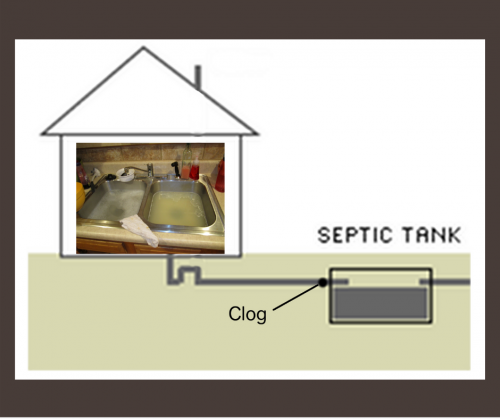
To “Unclog the Drain,” use 3 flat fingers on your right hand (Girl Scout Pledge style) and place them on and above your collar bone on the left side.
Pretend you are a gecko and make your fingers stick to your skin. Next, gently pull toward your right elbow as far as the skin will stretch comfortably. Hold this position for 3 seconds, then let go. Put your fingers back in the same position and do the same action again.
Repeat this 20-30 times. When you are done, do the same thing on the other side. (Always use the arm on the opposite side of the body from the collar bone – right arm for left collar bone and left arm for right collar bone).
Step 2:
Clearing Out Your Lymph Nodes
Lymph Nodes are all over our bodies. They are the things doctors feel for in your neck when they think you might be sick.
What Lymph Nodes Do
Lymph nodes function like a fuel filter in a car. If you put bad gas full of gunk in your tank and it makes it to your engine, you have to pay thousands of dollars to replace your engine. To avoid this, cars have a fuel filter that is in the fuel line running between the tank and the engine. If gunk is in the tank, it gets trapped in the fuel filter, saving the engine.
Likewise, lymph nodes catch bad things like bacteria and viruses when they get into our bodies. Special immune cells hang out there waiting for foreign invaders. When they identify things that shouldn’t be in our bodies, they send out an alarm for other immune cells to come to that lymph node. This is why they swell up when we are sick.
The lymph nodes then serve as a battle ground where invaders are (hopefully) destroyed. Because of there can be bad stuff hanging out in there and the fact that it all dumps into the bloodstream, you never want to move your lymph if you think you are sick! Please keep this in mind.
Once invading pathogens like bacteria and viruses have been broken down and are no longer a threat, they then harmlessly pass through the lymph nodes and into the bloodstream. The liver continues to break down what remains.
Also of importance to understand is that our lymphatic system functions as a sewer system for the body. Any regular old gunk and junk – cell waste, dead cells, toxins, etc. are all collected by the lymphatic system and returned to the blood stream to be processed by the liver.
As a result, when there are lots of dead cells around – like after surgery, the lymph nodes (filters) tend to get clogged up, blocking fluid drainage. So, we need to clear them out.
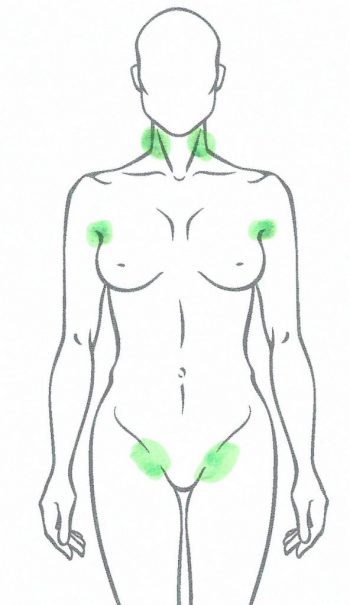
Location of Lymph Nodes Important for This Tutorial
Begin by clearing the lymph nodes in your neck.
To do this, with a flat hand, place it on the side of your neck. Just like in the Unclogging the Drains step, use the arm on the opposite side of the body from the area you are clearing. Use the right arm for the left side of the neck and the left arm for the right side of the neck.
With your hand on the skin on the side of your neck, pretend you are a gecko and while sticking to the skin, pull the skin downwards toward your collarbone.
Do this on each side 20 times. If your plastic surgery was on your neck, you should do this with a feather-light touch if you are in the first 3 weeks of recovery.
(If you only had a facelift, proceed to the facelift procedure below as the steps pertaining to the body are not relevant to you.)
Next, you want to clear the lymph nodes in your underarms.
Put something stiff under there – like your fist, a wadded up washrag, or a tennis ball. Squeeze your arm toward your body. Do this 20 times on both sides.
To get the right amount of pressure, pretend there are grapes in your underarm and that you are trying to gently and slowly squeeze the juice out of them – not destroy them!
Then, breathe deeply.
Before we move on to the lower body, you should take a couple of minutes to take several deep belly breaths.
During a normal lymphatic drainage session for someone who has not had surgery, there is a sequence that is done on the abdomen to move the lymph pathways deep in the body. If you have had surgery in this area, you shouldn’t do this.
What you can do is take deep breaths. This helps because the tube (called the Thoracic Duct) that carries the lymph up to our collar bones from deep in our abdomen has to pass through the diaphragm. Deep breathing “milks” this tube and propels fluid along it.
Now, you should clear the lymph nodes in your groin
Where your leg meets your body – in your groin area, take your flat hand and press while scooping upwards towards your abdomen.
Just like with the armpits, imagine that you are trying to carefully squeeze the juice out of grapes – not squish them until they disintegrate.
Do this 20 times on both sides.
Step 3:
Move Fluid Towards
Your Lymph Nodes
Now that the lymph nodes are clear, move the fluid towards them
Once our drain and lymph nodes in the armpit and groin have been cleared out, it’s time to move fluid/swelling towards them.
To do this, you will use a flat hand (or hands) on the skin – again pretending you are a gecko so that you pull the skin, not brush over it. You should use light pressure and not push down toward the muscle. Focus only on moving the skin. If you haven’t watched the video above, it shows you how to do this correctly.
The reason you are tugging on the skin is to open up the lymphatic capillaries to let fluid into the lymphatic system so you can move it. The lymphatic capillary (shown below) has little flaps that must open to allow the fluid between the cells (swelling) to go inside. Tugging on the skin opens the flaps.
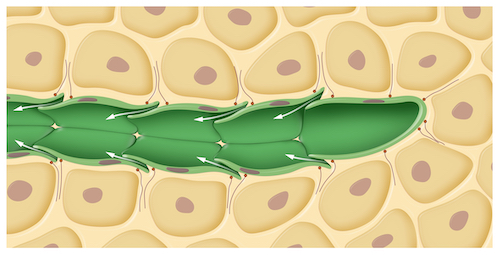
If you have had surgery within the last few days, be extra gentle – think “light as a feather.” As you heal you may use a little more pressure. Even at its deepest level of pressure, lymphatic work never goes deeper than the skin.
Start with the skin closest to the lymph nodes in the area where you are working. Place your hand flat on your skin and pull toward the lymph nodes. Repeat 7-10 times.
Pick up your hand and place it a little further away from the lymph nodes. Repeat the skin tugging motion 7-10 times.
Watersheds
Repeat the skin tugging motion, moving your hand after each sequence of 7-10 repetitions until you reach a boundary line, or “watershed.” These watersheds are pictured in orange on the diagram below. Lymph nodes in the armpits and groin are pictured in green.
Watersheds are boundaries where lymphatic fluid does not easily cross. If you will notice on the diagram below, on either side of an orange watershed line, fluid drains in opposite directions.
It’s also good practice to help keep those lymph nodes clear by periodically repeating Step 2: Clearing Your Lymph Nodes.

Normal Lymphatic Drainage Pathways
Doing The Back of the Body
Before doing the back of the body, be sure that you have followed Step 1: “Unclogging the Drain” and Step 2: Clearing Your Lymph Nodes.
While these steps are on the front of the body, it’s where you will be moving fluid, so be sure to do them in order before moving on to the back. Also, if you have had work done on your front, you will want to do Step 3: Move Fluid to the Lymph Nodes for the front of the body first before doing your back.
When you are doing self-lymphatic massage getting to the back of the body is a real challenge. If you have someone to help, ask if they will do this for you. Be sure that they have clean hands (especially if you have open wounds or scars)!
If you are on your own, don’t worry. While it is ideal to work on most of those areas directly, you will still get improvement by getting to the areas that you can reach.
Lymphatic Drainage (lymphatic massage) works on the principle of creating a vacuum within the lymphatic system. As we work backwards from the area where the lymph dumps into the bloodstream at the collar bones to the area where there is swelling, we are creating a type of suction. Have faith that it is working even in places you can’t reach.
Tummy Tuck and Body Lift Modifications
Tummy Tucks and Body Lifts mean that you need to make some modifications to your lymphatic massage patterns.
This is true because of a couple of things. First and foremost, you now have a great big scar through which lymph cannot pass and you will need to re-route your fluids.
Second, some of your skin has been removed and that means that the lymphatic pathways were affected. In a tummy tuck, for example, if your old belly button hole was pulled all the way down to your pubic bone (if you don’t have a vertical scar between your belly button and your pubic bone), the watershed (boundary pictured in orange below) that once existed at your waist is now at your pubic bone.
That means that everything above the scar naturally will flow up toward your armpits.
It gets a bit more complicated if you have a vertical scar below your belly button. This means that part of the watershed that used to drain to your groin area is now above your scar. The fluid can’t go through the scar, and it won’t naturally go up to your underarms.
Moving this fluid effectively takes a bit more effort and a lot more skill than I can go into detail about here. However, if you follow the movement patterns on the diagram below, you will probably still get some effect. Don’t become too frustrated if you aren’t as successful.
This is advanced stuff that Lymphedema Therapists have special training to do. It’s still worth working on. Any swelling you can get to go down is better than nothing.
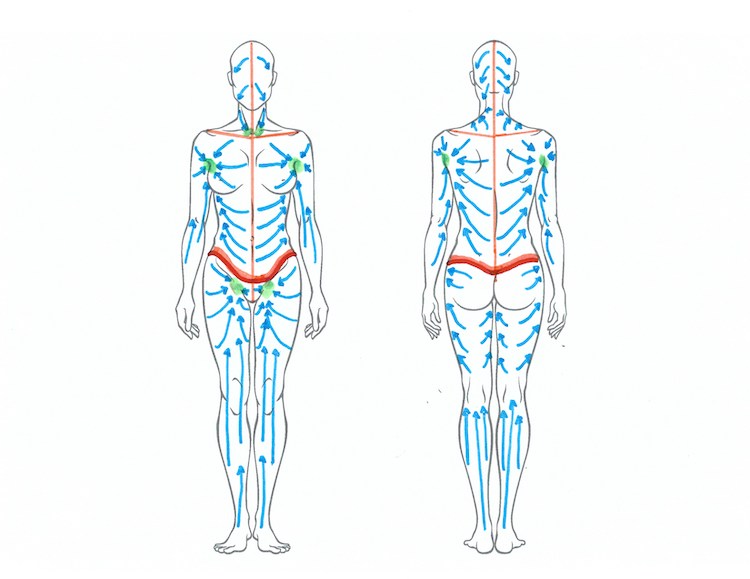
Genital Swelling After Plastic Surgery
This topic deserves its own post.
Yes, it’s common.
There is something you can do.
Make sure you have watched the video above and understand the instructions for general lymphatic massage. Then, head over to this page: Is Genital Swelling Normal After Plastic Surgery for specific instructions about how to deal with this area of the body.
Facelift Lymphatic Massage Directions
Facelifts are pretty much the same as the rest of the body, you just need to be a lot more gentle.
Some of the most delicate skin on the body is found on the face, and since lymphatic massage requires it to be tugged you must have a seriously light touch.
First, instead of using your full hand, just use the part of your fingers from the finger tip to the second knuckle. Focus on using as little pressure as you can while still managing to get the skin to move when you move your hands.
Also, instead of trying to tug your skin as far as it will stretch, you should only move it slightly – and in the correct direction (see the diagram below).

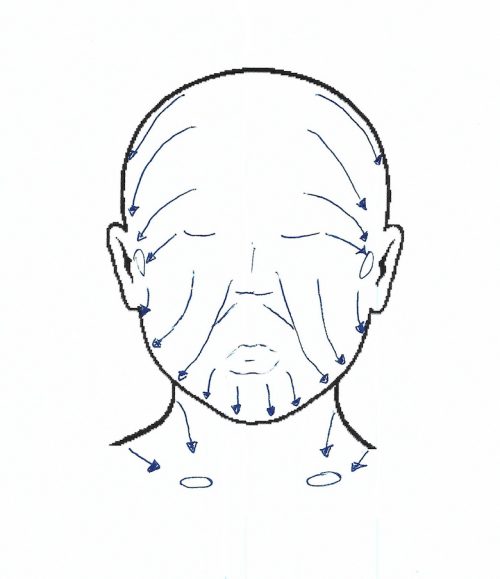
COMPRESSION, COMPRESSION, COMPRESSION
And other stuff
that will help you out right now.
Your surgeon has likely put you in a faja (body girdle),
or a compression mask if you had a facelift.
WEAR IT.
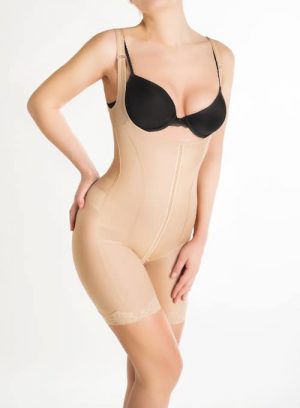
Your best friend right now is your compression garment. Compression is what helps to keep the fluid from building up.
Yes, you are going to swell even with good compression, but it really helps – even if you wish it would work better.
Make Sure You Have a
Good-Fitting Faja or Face Mask
Rule of Thumb: Your faja should be tight enough that you feel it in your arms when you try to close it.
It should not be so tight that it takes 3 people to get you into it. (Yes, I have actually witnessed this in my practice.) One good brand of faja I recommend is MyD.
There are several different fajas to choose from; however many that you get online are not very good. I’ve asked for samples from tons of suppliers, and I’ve found very few good ones. Here are Amazon links to the ones I carry in my practice.
Some Quick Notes about Fajas:
There are tons of faja shapes and styles out there, and you should choose what fits you best. That being said, here are some guidelines for choosing a good faja.
Get coverage for more than the area of surgery.
By that I mean if you had surgery on your abdomen, don’t get a faja that stops at the panty line where the legs meet the body. Get one that goes at least half-way down the thigh. If you had lipo on your upper thighs, you need one that goes to your knees. If you got lipo down to your knees, you need a faja that goes to your ankles. Likewise, if you are having swelling in your legs after surgery, a faja that goes to your ankles is a good idea.
If your surgery was anywhere on the trunk of the body,
get a faja that goes as close up to the armpit as possible.
Lots of fluid drains up there, so don’t stop your compression lower (like at the bra-line). You can form a pooch right above that area – as well as right below.
Spanx and other “shapewear” is NOT adequate compression in the first 3 months following surgery. It stretches waaay too much and will not help resist swelling, nor will it help to move it into your lymphatic system. While it is tempting to want to wear it, it won’t help you and could potentially cause issues.
If you are over 3 months post-op and wish to wear shapewear during the day and your faja at night, you are probably ok. Be sure to avoid options that have big thick seams or stays that can leave impressions in your fat. While it is unlikely at this time that these will cause permanent marks, they aren’t your best option.
Use Foam in Your Faja
Foam can help you in several different ways.
First, it can take up extra space in your faja if it is starting to get loose as you reduce.
Second, and very importantly, it helps to keep the faja from bunching on the sides. When fajas bunch up at the waist they restrict lymphatic flow. This means your swelling doesn’t go down like it should and you will likely form lumps and bumps easier.
Use Ab Boards and Back Boards in Your Faja
Ab boards and backboards are super important. They help to make compression stronger, and if you have had a tummy tuck or a body lift, they help to keep your skin flat and in place so it will lie back down in a neater fashion.
Ab boards should ideally be worn with a piece of foam underneath to keep them from creating creases in the skin. Here’s a link below to my favorite ab board that I recommend to my clients.
Back boards come in a couple of different varieties depending on your need. Many ladies who have had a BBL but no lipo up on their rib cage would best be served by this style of back board which goes in the small of the back.
If you had Lipo on your back, or if you are experiencing swelling that goes higher than your lower back, this is the back board I recommend. It should reach up onto the ribs.
I hope this info has been helpful to those of you who
need help if you haven’t been able to get in to see me
as quickly as you would have liked.
If you have questions that aren’t answered here, please feel free to send me an email via the contact page on this website. I’ve tried to cover most of the bases, but there are likely a lot of questions that you guys still have. I would love the opportunity to answer them and add them to this site to help others. 🙂
If you are in or near the Albuquerque area and you found this resource helpful,
I look forward to helping you!
–Shannon
Since you are here,
you might also be interested in these things:
What Is Normal After Plastic Surgery (And What Isn’t)
Here I answer common questions I get about day-to-day surgical recovery issues.

